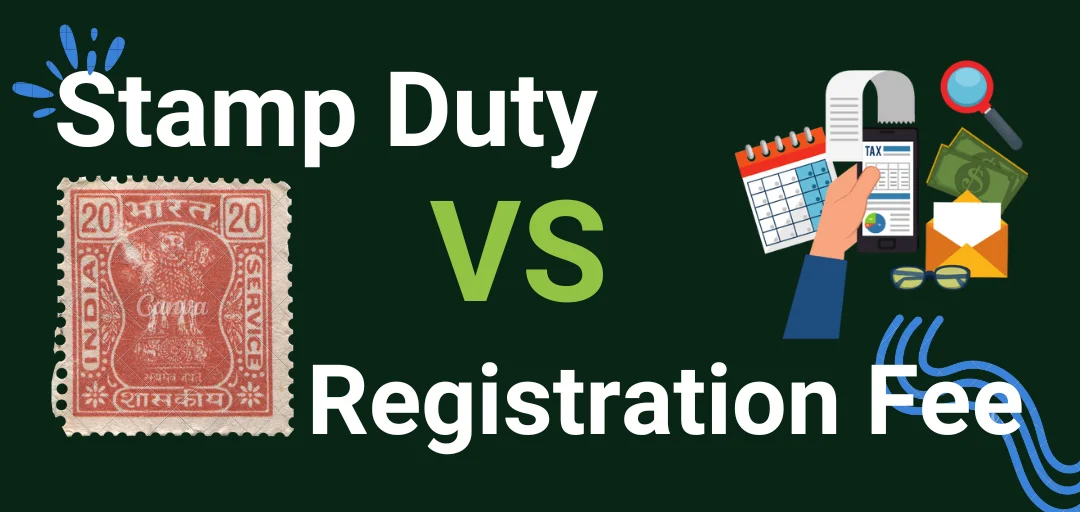Stamp Duty vs Registration Fee: Key Differences Explained
When it comes to property transactions in India, two terms that often come up are stamp duty and registration fee. While they are both important charges involved in the purchase of property, many people find it difficult to distinguish between the two. In this blog, we will explore the differences between stamp duty vs registration fee, their purpose, how they are calculated, and their relevance in property transactions.
What is Stamp Duty?
Stamp duty is a tax levied by the government on legal documents related to the transfer of property. It is an important step in the legal recognition of property ownership and ensures that the transfer of ownership is recorded with the government. This tax is paid to the state government and is a one-time payment made at the time of property registration.
The stamp duty amount is based on the value of the property being transferred. In some cases, the value may be determined by the market rate of the property or the value stated in the sale deed, whichever is higher.
What is Registration Fee?
The registration fee, on the other hand, is the charge levied for officially registering the sale or transfer of property with the government. It is a fee paid to the local sub-registrar’s office for registering the document and ensuring that the transfer of ownership is legally recorded. This is a separate fee from the stamp duty.
While the registration fee is generally a small percentage of the property value, it is mandatory for completing the property transaction process. The registration fee is not based on the value of the property but is a fixed percentage as prescribed by the state government.
Key Differences Between Stamp Duty vs Registration Fee
Now that we have a basic understanding of both stamp duty and registration fee, let’s look at the key differences between stamp duty vs registration fee.
Purpose:
- Stamp duty is a tax levied by the government to make a document legally valid. It signifies the legal recognition of the transaction.
- The registration fee is a charge for recording the document in the government records to create an official public record of the transaction.
Basis of Calculation:
- Stamp duty is calculated based on the value of the property being transferred. It can vary depending on the market rate, the property’s location, and the type of property.
- The registration fee is usually a fixed amount or a percentage of the property value, but it is generally lower than the stamp duty. The percentage may vary depending on the state.
Payment:
- Stamp duty is paid at the time of signing the document and is typically paid on the same day the property transaction is completed.
- The registration fee is paid after the document is signed, usually at the time of registering the property with the sub-registrar.
Effect on the Property Transaction:
- Without paying stamp duty, the property transaction will not be legally recognized, and the transfer of ownership cannot be completed.
- The registration fee ensures that the document is properly recorded with the local authorities, providing legal protection to the buyer and seller.
Exemptions and Discounts:
- Some states may offer discounts or exemptions on stamp duty for specific categories of people, such as women buyers or senior citizens, and sometimes for the purchase of properties in certain areas.
- The registration fee, however, is usually a fixed percentage with no significant exemptions or discounts.
Penalty for Non-Payment:
- If stamp duty is not paid or is underpaid, it can result in the transaction being considered invalid, and a penalty or fine may be imposed by the government.
- Failure to pay the registration fee results in the property transaction not being officially recorded, which could lead to legal issues in the future.
State-Specific Variations:
- Stamp duty rates and calculation methods can vary significantly from state to state. Each state government has the authority to determine the rate at which stamp duty is charged on property transactions.
- Similarly, the registration fee also differs across states, though it is usually a smaller amount compared to stamp duty.
Calculation of Stamp Duty vs Registration Fee
To further understand the key differences between stamp duty vs registration fee, let’s look at how each of them is calculated:
Stamp Duty:
The stamp duty on property transactions is calculated based on the value of the property. The state government typically decides the stamp duty rate, which can range from 4% to 7% of the property value, depending on the state. In some cases, the stamp duty may be based on the market value, while in other cases, it is based on the agreement value.Registration Fee:
The registration fee is generally calculated as a percentage of the property value or as a fixed amount. It can range from 0.1% to 1% of the value of the property, again depending on the state in which the property is located. Unlike stamp duty, the registration fee is generally much lower.
Example of Stamp Duty vs Registration Fee Calculation
Let’s assume you are buying a property worth ₹50,00,000. The stamp duty and registration fee will be calculated as follows:
- Stamp Duty: If the stamp duty rate is 5% in your state, the stamp duty would be ₹50,00,000 x 5% = ₹2,50,000.
- Registration Fee: If the registration fee is 0.1% in your state, the registration fee would be ₹50,00,000 x 0.1% = ₹5,000.
Conclusion
In conclusion, both stamp duty vs registration fee are important components of property transactions, and both must be paid to ensure that the transaction is legally valid and recorded. While stamp duty is calculated based on the value of the property and is a higher cost, the registration fee is usually a smaller, fixed cost that is required for the legal registration of the property.
When planning to buy or sell property, it’s essential to understand the differences between stamp duty vs registration fee to budget appropriately and avoid any confusion during the transaction. Make sure you check with the relevant authorities in your state to understand the exact rates and processes involved in these charges.
Our GST Services For E-commerce Sellers

All E-commerce Tax services
E-commerce tax services help online sellers navigate GST registration, compliance, return filing, TCS management, tax planning, and audits, ensuring efficient tax management and legal compliance.

GST Filing
GST filing is the process of submitting tax returns to the government, detailing sales, purchases, and taxes paid or collected, ensuring compliance with GST laws.

GST Registration
GST registration is the process where businesses obtain a GSTIN from the government, allowing them to collect taxes, claim input tax credits, and comply with GST laws.





